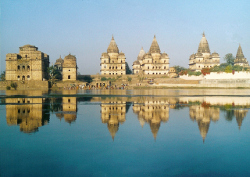Orchha on UNESCO world heritage sites 27/05/2019 – Posted in: Daily News – Tags: Bundela architecture
ORCHHA TOWN – BUNDELA ARCHITECTURE
For: Preliminary
Topic covers: About Orchha town, its historical background, Bundela architecture
News Flash
The architectural heritage of Orchha town in Madhya Pradesh have been included in UNESCO’s tentative list of world heritage sites following a proposal sent by the Archaeological Survey of India to the United Nation body.
- It would be the 38th site in India to form part of the treasured list.
- Three historically famous sites in MP, including the rock shelters of Bhimbedka, Buddhist monuments at Sanchi, and the Khajuraho group of monuments are among the 37 Indian heritage sites on the UNESCO list.
According to the rules, to be a part of UNESCO’s World Heritage sites, the heritage or any historical site first has to be on the tentative list. After it makes to the tentative list, another proposal is sent to the UNESCO.
Background
The ASI in its earlier proposal had requested to include Orchha in the list of cultural heritage.
Orchha, Madhya Pradesh
- Orchha is situated on the banks of the Betwa river.
- The town depicts peculiar style of the Bundela dynasty.
- Orchha was built by king Rudra Pratap Singh of Bundela dynasty in the 16th century.
- The ancient town is famous for its Chaturbhuj Temple, Orchha fort complex, Raja Mahal among others.
Orchha is also famous for its two elevated minaret called Saavan and Bhadon and its four palaces — Jahangir Palace, Raj Mahal, Sheesh Mahal and Rai Praveen Mahal — and for its concept of open bungalows, stone work windows, animal statues depicting the culture of Bundelkhand.
It is the only place in India where Lord Ram is worshipped as a king with a dedicated temple in his name called Sri Ram Raja Mandir.
Bundela architecture
- It was the town of Orchha where the beginnings of Bundela architecture were made by Raja Rudra Pratap (1501-31 A.D.)
- The Bundela architecture has Mughal influence since the two dynasties were very close.
- Strong and wide fortification walls made of large square stone boulders placed on the top of each other, without a cementing material surround the whole settlement.
- The main entrance or Pramukh-Dwar is situated in the north of the city and is presently connected with Jhansi-Manikpur road.
- This gateway is a double storied structure and has a four centered Mughal arch on its facade.
- An anlaysis of the architectural forms developed during the period of the Bundela rule (16th & 17th centuries AD) suggests a unique sequential development of domes, brackets, arches, pillars, roofs, niches, and squinches which make up the palaces, temples and the civil structures within the fort.
Source: The Hindu
You can follow us on LinkedIn and for more updates related to UPSC IAS Preparation, Like our Facebook Page and subscribe our Diligent IAS Youtube Channel
Also Read Related Daily News

